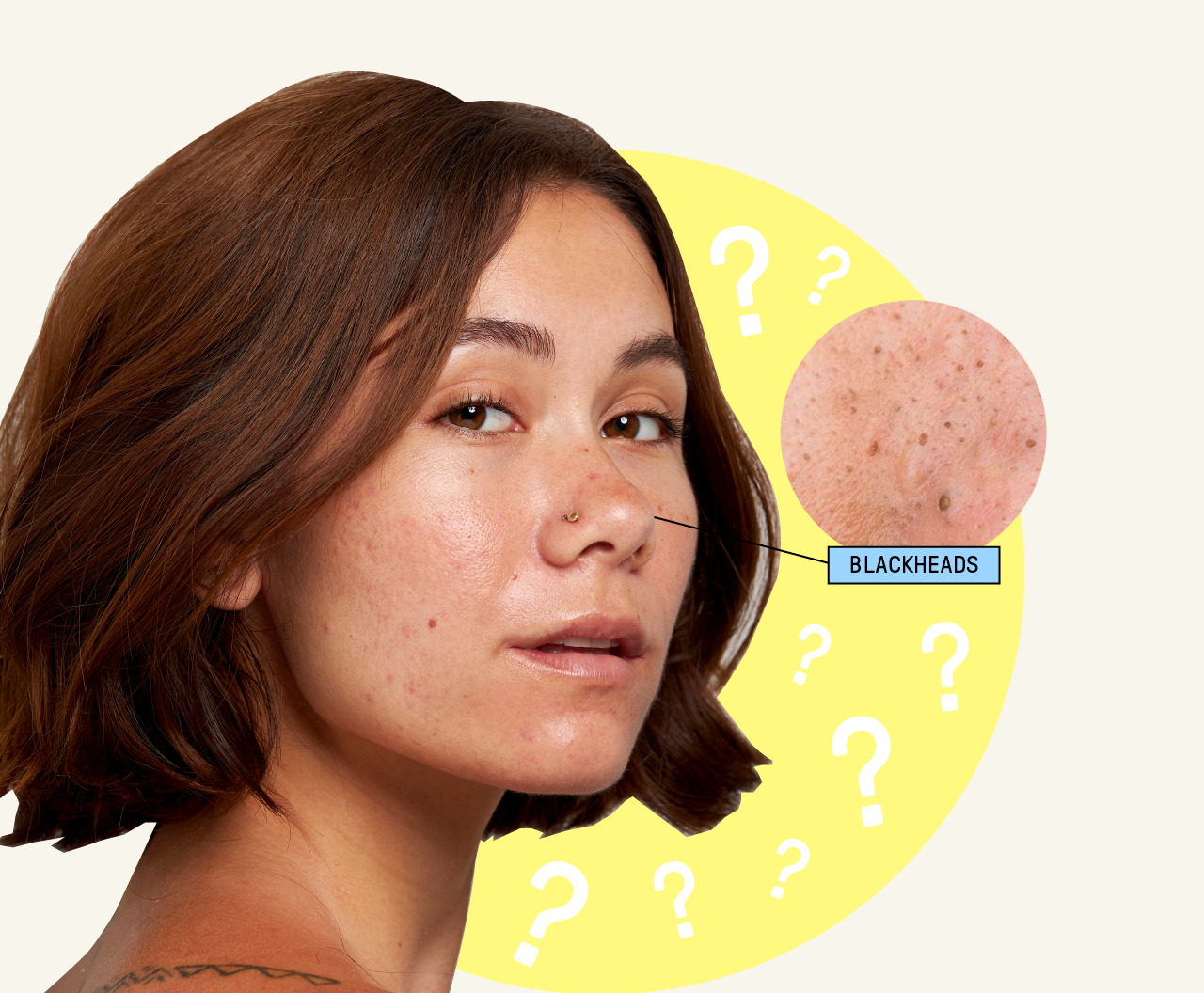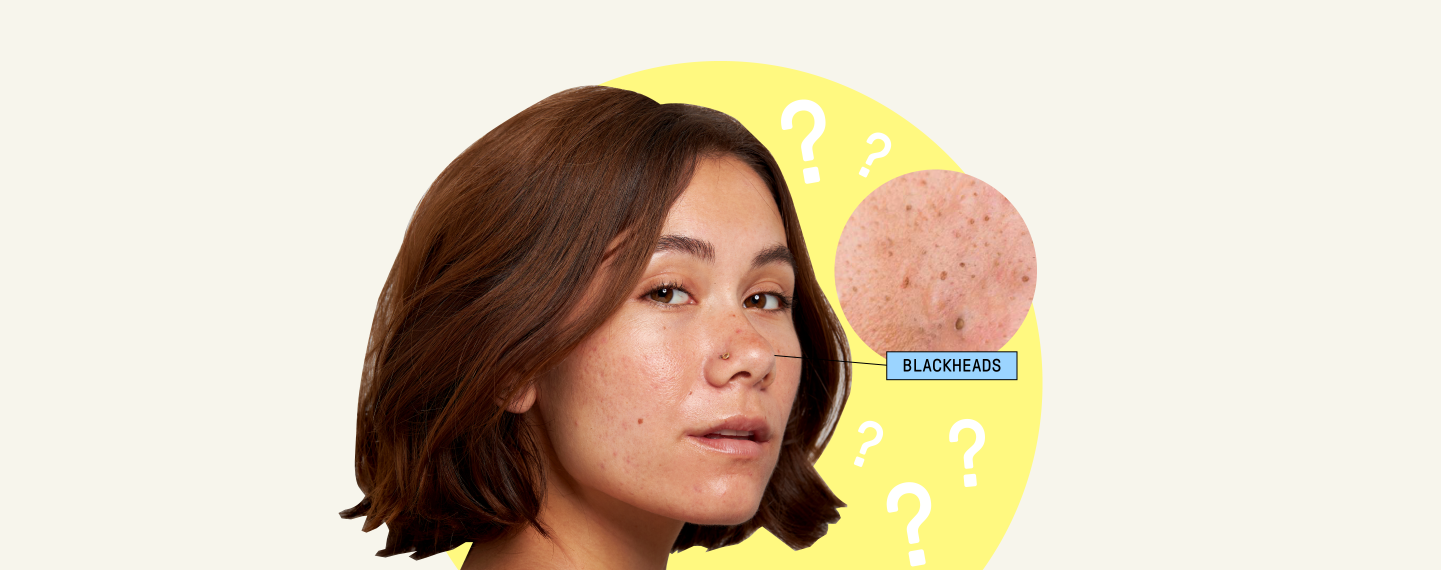Apostrophe Treatments
Tretinoin For Blackheads: Usage, Efficacy, Safety


SHARE
Apostrophe Treatments
Tretinoin For Blackheads: Usage, Efficacy, Safety
Medically reviewed by Michele Emery, FNP
Written by Apostrophe Team
Last updated 11/1/2024
Blackheads are a type of comedonal acne that can develop when your hair follicles, or pores, become clogged with sebum and dead skin cells.
Although blackheads are a mild and usually painless form of acne, they can become a major annoyance when they develop in large numbers. Luckily, blackheads are treatable with many skin care products and medications, including tretinoin.
Below, we’ve explained what blackheads are and how they can develop. We’ve also covered how you can use tretinoin to get rid of existing blackheads and prevent new blackheads from developing on your face and body.
What Are Blackheads?
Blackheads are a form of mild, non-inflammatory acne. They develop when the hair follicles in your skin become clogged due to the buildup of sebum and dead skin cells.
Sebum is a type of natural oil that’s secreted by your sebaceous glands -- small, oil-producing glands that are located inside your skin. It helps to seal moisture inside your skin and prevent your skin from becoming damaged.
Dead skin cells are produced as a result of your skin’s epidermal turnover cycle -- a process in which new cells are created to replace old ones. Your skin “turns over” approximately every 40 to 56 days as new cells travel from the basal layer of the epidermis to the surface.
When sebum and dead cells build up on the surface layer of your skin, they can clog your hair follicles and contribute to the development of comedonal acne.
Comedones can be closed or open. Closed comedones have a yellowish-white color and may be referred to as whiteheads. Open comedones, which have a dilated opening, are referred to as blackheads.
Contrary to popular belief, blackheads aren’t dark in color because of dirt or poor hygiene. The dark color of blackheads is caused by a chemical reaction called oxidation, which occurs when the melanin in the comedone is exposed to air.
Blackheads can develop in any part of your body. They’re most obvious when they develop on the face, but can also affect your chest, shoulders, back, neck, arms, and other areas.
Causes of Blackheads
At a basic level, blackheads and other forms of acne develop when sebum and dead skin cells clog your hair follicles or pores.
However, behind the scenes, a variety of different factors may increase your risk of developing oily skin that’s prone to blackheads. These include:
Hormones. Male sex hormones, called androgens, play an important role in regulating the function of your sebaceous glands. High levels of these hormones may cause oily skin and increase your risk of developing blackheads.
Genetics. Although there’s no single acne gene, genetics do play a role in your risk of developing acne. Researchers have identified more than 100 gene variants involved in acne breakouts.
Skin or hair care products. Some skin and hair care products contain oils that can clog your hair follicles and cause acne breakouts. Acne-causing ingredients can be found in some types of sunscreen and makeup products.
Does Tretinoin Prevent Blackheads?
Tretinoin is a prescription retinoid. It’s approved by the FDA as a treatment for acne vulgaris (the clinical term for acne). It’s also used to treat many common signs of skin aging, such as rough skin, hyperpigmentation, and wrinkles.
Tretinoin works by increasing the rate at which your skin produces new cells. This stimulates the shedding of dead, leftover cells that can build up on the surface layer of your skin and contribute to clogged pores and acne breakouts.
In a way, you can think of tretinoin as acting almost like a fast-forward button for your facial skin cells.
Countless studies have shown that tretinoin treats and prevents acne. In fact, tretinoin and other retinoids are so effective at controlling acne that some research refers to them as a mainstay of therapy for acne breakouts.
Since tretinoin works by preventing dead skin cells from clogging pores, it’s effective at reducing all forms of acne, including comedones such as blackheads.
By preventing clogged pores, tretinoin stops whiteheads and blackheads from developing in the first place. It also helps to unclog pores and get rid of existing acne breakouts.
Our guide to tretinoin goes into more detail about how it works for blackheads, whiteheads, and other forms of acne.
How to Use Tretinoin to Treat Blackheads
As a topical medication, tretinoin is easy to use. It’s available as a lotion, cream, gel, and in skin care products.
It’s best to use tretinoin before you go to sleep. Before applying tretinoin, wash your hands and the affected areas of your face with mild soap. Dry your skin, then wait 20 to 30 minutes before applying tretinoin.
Apply tretinoin to the affected areas of your face using your fingertips. Make sure to only use a small amount of tretinoin -- enough to cover the areas of skin with acne with a small layer of the medication.
When applying tretinoin, make sure to avoid your mouth, eyes, nostrils, and ears. Do not apply tretinoin if your face is sunburned.
If you have dry skin, consider using a moisturizer with tretinoin. It’s best to wait 20 to 30 minutes after applying tretinoin before using moisturizer to allow your skin to fully absorb the medication.
Tretinoin can cause side effects, including an increase in your sensitivity to sunlight. Try to limit your sun exposure while you use tretinoin and apply an SPF 30+, broad-spectrum sunscreen to keep yourself protected when you’re outdoors.
Other Options for Treating Blackheads
Topical tretinoin is one of the most effective options for dealing with blackheads, whiteheads, and other forms of facial acne. However, it’s not the only treatment option that’s available if you have acne-prone skin.
Other acne treatment options for blackheads include:
Other topical retinoids. In addition to tretinoin, other topical retinoids can help to get rid of blackheads and other types of acne. Popular over-the-counter retinoids include retinol and adapalene (sold as Differin® gel).
Alpha-hydroxy acids (AHAs) and beta-hydroxy acids (BHAs). AHAs and BHAs such as glycolic acid and salicylic acid are commonly used to treat acne breakouts, including comedonal acne and more severe acne.AHAs and BHAs work by promoting exfoliation -- the process of shedding dead skin cells that can contribute to clogged hair follicles.
Benzoyl peroxide. Benzoyl peroxide is a common ingredient in cleansers that works by preventing the growth of acne-causing bacteria. It’s mostly used to treat inflamed acne, but it’s also moderately effective at treating comedonal acne such as blackheads.
In addition to the right skin care products, good habits can help to reduce your risk of developing blackheads and other forms of acne. Try the following habits and lifestyle changes to stop acne from developing:
Use a gentle cleanser. Cleansing your face helps to remove dead skin cells, excess oil, and bacteria. If you have sensitive or dry skin, use a gentle cleanser that’s free of alcohol or other harsh ingredients.
Try not to scrub your skin. Scrubbing can cause skin irritation and increase your risk of dealing with more severe acne. Avoid scrubbing your skin with a cloth or sponge. Wash your skin carefully using lukewarm water and pat it dry using a clean towel.
Try not to touch your face. Touching your face can spread bacteria from your hands to your skin. Try to avoid touching your face unnecessarily. If you need to touch your face, such as to apply skin care products, make sure to wash your hands thoroughly.
Avoid popping pimples. The temptation to pop blackheads can be immense, especially if you have obvious ones on your nose, cheeks, or forehead. However, it’s best not to pop your own acne lesions, including comedonal acne such as blackheads. This is because popping pimples can cause infections, scarring, and more painful acne. If you have large blackheads that you’d like to remove, consider getting them extracted by a dermatologist.
Use non-comedogenic skin care products. Some skincare products contain oils and other ingredients that make acne worse. Look for products labeled “non-comedogenic” or “oil-free.” These are formulated to reduce your risk of developing blackheads.
Wash your hair regularly. If you’re prone to blackheads on your scalp and forehead, try to shampoo your hair regularly. This may help to prevent natural oil from your scalp from clogging your hair follicles and causing breakouts.
Dealing With Blackheads
While blackheads are a mild form of acne, they can have a serious impact on your appearance when they develop on your nose, forehead, and other highly visible parts of your face.
To deal with blackheads, use the techniques above and consider adding a tretinoin product. Tretinoin can take several weeks to work, but the results are real and noticeable. Not only can it help you to get blackheads under control -- it can also treat moderate acne and reduce your risk of developing wrinkles and other signs of skin aging.
You can learn more about using tretinoin to control breakouts in our full guide to using tretinoin for acne. You can also access our full range of skincare treatments online to get started dealing with acne, dry skin, fine lines, and other common annoyances.
Hoover, E., Aslam, S. & Krishnamurthy, K. (2020, October 26). Physiology, Sebaceous Glands. StatPearls. Retrieved from https://www.ncbi.nlm.nih.gov/books/NBK499819/
Koster, M.I. (2009, July). Making an epidermis. Annals of the New York Academy of Sciences. 1170, 7-10. Retrieved from https://www.ncbi.nlm.nih.gov/pmc/articles/PMC2861991/
Acne. (n.d.). Retrieved from https://www.americanskin.org/resource/acne.php
Heng, A.H., Say, Y.-H., Sio, Y.Y., Ng, Y.T. & Chew, F.T. (2021). Gene variants associated with acne vulgaris presentation and severity: a systematic review and meta-analysis. BMC Medical Genomics. 14, 103. Retrieved from https://bmcmedgenomics.biomedcentral.com/articles/10.1186/s12920-021-00953-8
10 Skin Care Habits That Can Worsen Acne. (n.d.). Retrieved from https://www.aad.org/public/diseases/acne/skin-care/habits-stop
Acne. (2021, December 7). Retrieved from https://medlineplus.gov/acne.html
Yoham, A.L. & Casadesus, D. (2020, December 5). Tretinoin. StatPearls. Retrieved from https://www.ncbi.nlm.nih.gov/books/NBK557478/
Weiss, J., Leyden, J. & Stein-Gold, L. (2017, September). Why Topical Retinoids Are Mainstay of Therapy for Acne. Dermatology and Therapy. 7 (3), 293–304. Retrieved from https://www.ncbi.nlm.nih.gov/pmc/articles/PMC5574737/
Tretinoin Topical. (2019, March 15). Retrieved from https://medlineplus.gov/druginfo/meds/a682437.html
Alpha Hydroxy Acids. (2020, August 24). Retrieved from https://www.fda.gov/cosmetics/cosmetic-ingredients/alpha-hydroxy-acids
Salicylic Acid Topical. (2016, September 15). Retrieved from https://medlineplus.gov/druginfo/meds/a607072.html
Del Rosso, J.Q. (2008, November). What is the Role of Benzoyl Peroxide Cleansers in Acne Management? The Journal of Clinical and Aesthetic Dermatology. 1 (4), 48–51. Retrieved from https://www.ncbi.nlm.nih.gov/pmc/articles/PMC3016935/
Acne: Tips for Managing. (n.d.). Retrieved from https://www.aad.org/public/diseases/acne/skin-care/tips
How to Control Oily Skin. (n.d.). Retrieved from https://www.aad.org/public/everyday-care/skin-care-basics/dry/oily-skin
Pimple Popping: Why Only a Dermatologist Should Do It. (n.d.). Retrieved from https://www.aad.org/public/diseases/acne/skin-care/popping
Shop this post

Tretinoin
Like what you just read? Sign up for our email list to get the scoop on skincare science delivered straight to your inbox.

Deep Dives
A dermatologist shares his thoughts on the recent studies about benzoyl peroxide and benzene.
Read More
Education
What is milia?
What is milia? Today, we’re jumping into one type of bump that you may have heard about most commonly in infants — milia.
Read More
Education
Best moisturizer for acne-prone skin
If you have combination acne-prone skin, figuring out which moisturizer is best for your skin might be tough. In this guide, we break down the best moisturizer for combination, acne-prone skin.
Read More
